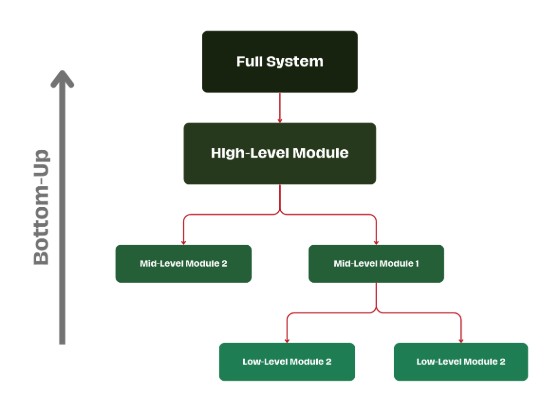Building a strong software system is like constructing a skyscraper. Starting with a solid foundation ensures everything above it stands firm. When designing software, it is essential to ensure the system remains stable as new modules are added.
This is where bottom-up integration testing comes in. Let’s explore how this approach can help create stable software systems.
What is Integration Testing?

Integration testing ensures different software components work together correctly. It follows unit testing and focuses on verifying interactions between modules. There are two primary approaches:
- Top-down integration testing: Testing begins at the highest level and moves downward.
- Bottom-up integration testing: Testing starts at the lowest-level components and moves upward.
Understanding Bottom-Up Integration Testing
Bottom-up integration testing is a methodical process in which lower-level modules are tested before being integrated, followed by progressively higher-level modules.
Key Steps in Bottom-Up Integration Testing
- Start with low-level modules Test individual functions or components before integrating them.
- Use temporary components (drivers) Since higher-level modules are unavailable initially, drivers simulate their behavior.
- Integrate progressively: Combine tested components and verify their interactions step by step.
- Move to higher levels: Continue testing by integrating additional modules until the entire system is covered.
The diagram below showcases the progressive integration of modules, where lower-level components are tested first before moving to higher levels.

Example of Bottom-Up Integration Testing
Imagine a clothing e-commerce platform with various software components. The lowest level consists of modules like product details, user authentication, and inventory management. Higher-level modules handle order processing and payment integration.
Using bottom-up integration testing, we would:
- Test the product details and inventory management modules individually.
- Create a simple test driver to verify these modules work together correctly.
- Integrate these tested components with the order processing module and test this larger subsystem.
- Finally, add the payment integration module and test the complete system.
This approach ensures each component works correctly before becoming part of a larger system.
Comparison of Bottom-Up vs. Top-Down Integration Testing

Advantages of Bottom-Up Integration Testing
- Early defect detection: Issues in lower-level modules are caught early, reducing debugging efforts later.
- Effective for complex systems: When lower-level components are crucial, this approach ensures their reliability first.
- Parallel development: Multiple teams can work on different components simultaneously.
- No need for stubs: Unlike top-down testing, which requires placeholder components (stubs), bottom-up testing only uses drivers.
However, top-down and bottom-up integration testing can also be combined in a sandwich approach, where both methods are used simultaneously.
When Should Bottom-Up Integration Testing Be Used?
This approach is beneficial when:
- Lower-level components are stable and critical to system functionality.
- High-level modules are still under development and unavailable for testing.
- You want to build from a strong foundation, ensuring core functions work before adding complexity.
- Developing complex architectures like microservices, which require testing foundational services before integration.
Final Thoughts
Bottom-up integration testing is a systematic, reliable approach to software testing. It stabilizes lower-level modules first and then moves upwards, reducing system-wide failures. It benefits large and complex applications where strong base modules are crucial but may require more test drivers.
By following this bottom-up approach in testing, teams can improve software quality and build more resilient applications.
